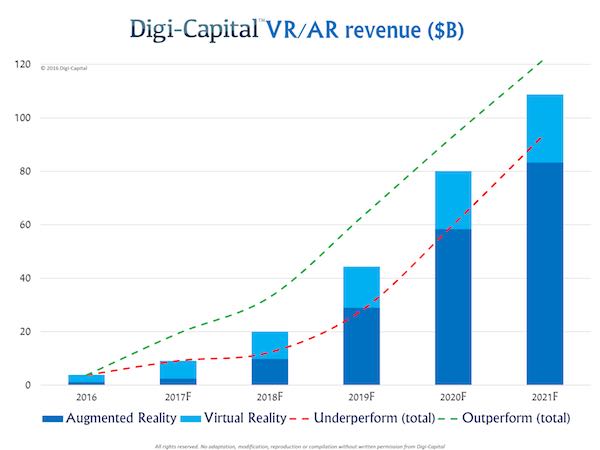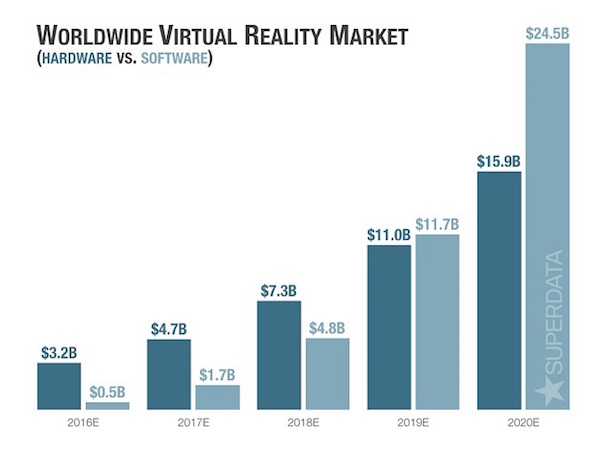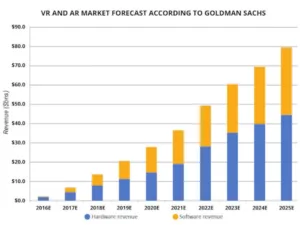When we talk about the success of VR and AR we typically reflect on some new market forecast that tells us how many billions AR / VR will create in near future. Independent of your belief in such forecast numbers, there is a real struggle out there on how to make such hardware and software more successful.

Since at Display Daily, we look at most technology developments in light of their connection with displays in general, we often write about this display or that new display technology that will make AR / VR so much better. Here, I want to pay attention to a complete different side, the users’ side and as a consequence offer a measuring stick for those wonderful market forecasts.
AR / VR Market Forecast by Goldman Sachs
The adoption of AR / VR devices seems to be limited by the way the devices are being used by the consumers. While business, industrial and even gaming are clearly defined applications, the use as a CE device is less clear. Since Facebook / Oculus was an early adopter the most anticipated application for the consumer seems to be social networking. In this particular field, as well as in other consumer applications, we should review how the nature of VR devices reflects human behavior. With a VR headset, the user is completely separated from his surroundings, one of the reasons why some see more long term success for AR in general. The question of how widely VR will be adopted is linked to the question as how ‘antisocial’ this device will be perceived to be by the consumer.
 AR / VR Market by Digi Capital
AR / VR Market by Digi Capital
Gaming is NOT antisocial
Since the only consumer application for VR, so far, is in gaming (or entertainment to choose an overlying term), I need to make it clear that gaming in itself is not antisocial by any means. In many ways, gaming is typically stereotyped as an activity that is performed by nerds, preferably in the parents’ basement. Studies have shown that this is not true.
For example a study by Life Course Associates in 2014 has shown that gamers are more educated and conscious about their friends compared to people not playing computer games. The definition for gaming was pretty low in this study as it was defined as a person who had played any kind of game in the last 60 days. The study also showed that gamers are more likely to live with other people (friends, family and significant others) than non-gamers. Yes, this study is already three years old, but most likely the same people are still playing games.
 VR Market Forecast by Superdata Is Social Media Antisocial?
VR Market Forecast by Superdata Is Social Media Antisocial?
This is a topic that I always wondered about. It all seems to be part of your perspective and the perspective changes pretty strongly with your age. Compared to a century ago, we have means of communication today that even science fiction would have had a hard time foreseeing at that time. Take your favorite science fiction movie and take a look at the communication hardware. The smartphone pretty much covers all of the things the authors could think of, maybe besides those phone calls to Mars, but who is going to pick up anyway?
With the appearance of text messaging and social networking, we are in a constant connection mode and communicate with our friends almost 24/7. I leave my phone out of the bedroom on purpose, but I know enough people who can’t even sleep without the phone by their side.
As a non-scientific review of the subject I asked around in my family if they perceive social media as pro-social or as anti-social. The results are in, the baby boomers answered ‘It depends’, the millennials said ‘antisocial’ and the teenagers did not understand the question. This is just one family based entirely in the USA so I do not claim any scientific significance, but the results were very, very clear cut along generational lines.
A recent book by San Diego State university professor Jean M. Twenge, PhD, “iGen: Why Today’s Super-Connected Kids Are Growing Up Less Rebellious, More Tolerant, Less Happy–and Completely Unprepared for Adulthood–and What That Means for the Rest of Us”, discusses the consequences of the youngest generation growing up with the smartphone and social networking. Her predictions are a little dire as the title suggests. She looks at children and young adults born between mid 1990’s and mid 2000’s and relates certain behaviors to the introduction of the iPhone. If you do not want to read the whole book the article ‘Have Smartphones Destroyed a Generation‘ in The Atlantic provides a summary of the book.
 Jean Twenge – Statistical portrait of the teenage smartphone generation
Jean Twenge – Statistical portrait of the teenage smartphone generation
The statistical portrait of teenage behavior in relation to the introduction of the iPhone does show a shift in behavior, the classical signs for the development of a new generation sometimes dubbed iGen.
It seems the definition of antisocial behavior may have been changing since Graham Bell, but so far mankind has survived this shift towards a non-personal communication style. Maybe the shift to texting and social networking among the younger generations is comparable to the shift of the baby boomers to phone calls, faxes and emails. I clearly remember my grandmother being very uncomfortable around a phone and I have never seen her pick up the receiver to talk to her neighbors.
What is Antisocial and Prosocial
When we talk about antisocial and prosocial behavior, we have very clear values attached to these words; however asking several people what they mean by that, shows that everyone has his own idea and definition of what these terms mean. Without a clear definition, it is impossible to agree if a device like the smartphone actually promotes antisocial behavior or not. When using these terms everyone tends to put the respective person under observation into these buckets. This is absolute, black and white, either or, there is no in between. I would argue that most people have prosocial and antisocial tendencies and that they show these behaviors depending on their mood and general wellbeing. In reality there is a wide range of behaviors that fall in between these terms and completely antisocial or prosocial persons are extremely rare or even not existing.
What an electronic device may do is promote one behavior over the other. For example a smartphone is promoting a one person interaction with the device, even though I have seen two children hovering over one device in their own form of screen sharing. This being the exception and not the rule, one could argue that mobile devices promote antisocial behavior. However, at the same time the person using social networks on a mobile device is more connected to a larger group of people than they ever were before. This can be considered as a form of prosocial behavior. As so often, the truth lies in the eye of the beholder.
More Breadth, Less Depth
It seems that mobile devices today promote both behaviors, antisocial and prosocial at the same time. This trend is not new in our society and it can be argued that as the global population has increased in the last hundred years the means to communicate with larger groups has grown as well. From the phone to faxing, emailing, texting and video chatting , the communication has always moved forward and allowed increased communication. This has always come at the price of a ‘lower quality’ or less involved communication with our nearest group of family, friends, etc. While the quantity of communication measured by how many people we communicate with, has increased the depth of that communication has decreased. Texting and social media is just another step in that development.
I would argue that social interactions via VR is just the next step in that evolution. More communication with many more people, at the cost of less in-depth direct contact with people. Just because the medium is different from what we have been doing so far does not mean that VR is per se antisocial. The real question will be, what mankind will accept as socially acceptable communication in the far future? If you could use a brain modem in the year 2525, thinking about someone might be considered prosocial behavior.
As a consequence, labeling VR interaction as antisocial will not work for younger generations, it all comes down what this new media promises in terms of quality and cost for communication and entertainment. When we look at the market forecasts we have to ask what the underlying addressable market is in the respective models.
I would argue that older generations will show more hesitance to adopting VR headsets compared to younger generations. From my personal experience, I would even guess that the millennial generation will not be a big driver of adoption either (I am only talking about consumer applications here). Anyone born after 1990 maybe the best bet to drive adoption. However this makes the addressable market much smaller and are a good reason to question the existing market forecasts.
The question that remains for me is how we differentiate between VR actions and real world actions. For us it is clear that actions in VR are very different from actions in the real world. Shooting monsters in VR is very different from shooting your neighbor’s dog in the real world. If VR becomes the normal form of communication, how do we learn this distinction?
The great science fiction story ‘The Naked Sun’ by Isaac Asimov explored this development in 1957, and it seems we are catching up to Asimov much faster than we thought. I guess all technical platforms bring with them the promise of a better world bundled with risks we have to learn to avoid. (NH)

